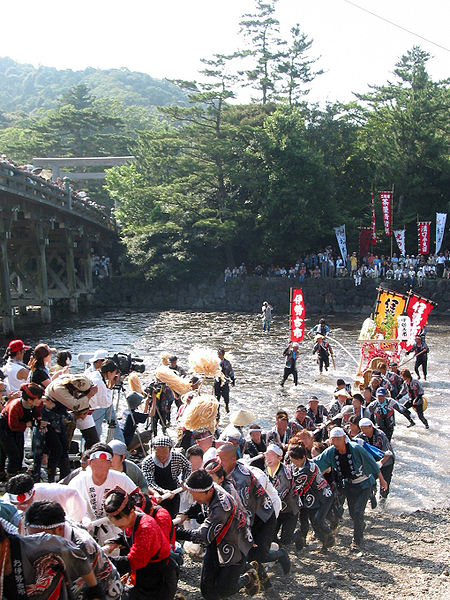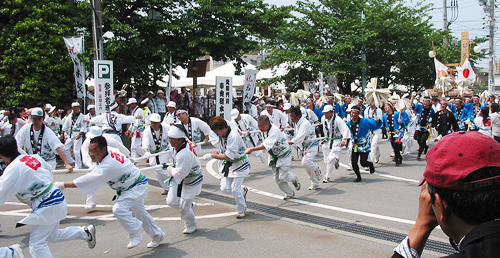Home > Junko's Blog > Musings on Resilience and an Ancient Japanese Festival
May 30, 2011
Musings on Resilience and an Ancient Japanese Festival

Some rights reserved by Tom BKK
I often ponder how can we still thrive and live happily--as individuals, communities, organizations, and nations--in the midst of the approaching era of challenges facing humanity.
Key words in my life are "connect," and "resilience" (though there is no exact translation in Japanese). The nearest equivalent for "resilience" in Japanese might be danryokusei (elasticity) and fukugenryoku (restorative ability), but I like to translate it into Japanese as shinayaka na tsuyosa (strength that is pliant or supple).
Below is an excerpt of an article I wrote for the Nikkei Ecology website to articulate my thoughts on these things, inspired by an experience in Japan.
〜〜〜〜〜〜〜〜〜〜〜〜〜〜〜〜〜〜〜〜〜〜〜〜〜〜〜〜〜〜〜
Nikkei Ecology, Series, No. 2 (What Really Makes Us Strong)
By Junko Edahiro, (May, 2007)
■ The Key to Sustainability: The Suppleness and Strength to Spring Back
In my previous article I described a visit to Ise Jingu (Ise is pronounced issay), Japan's forest-enshrouded, most sacred Shinto shrine, and covered the story from the perspective of sustainability. Ise Jingu mirrors eternity with the ceremonial relocation of the shrine structure every twenty years. I find this shrine a profound example of what is true strength.
In Western thinking, creating something strong would probably involve building a structure with a permanent, solid material like stone or concrete. But at Ise Jingu, structures made only from wood are to be rebuilt over and over again for all time. Simultaneously, in the process, the techniques of miyadaiku (shrine carpenters) and various other craftsmen are passed on from generation to generation.
Resilience is an important concept attracting attention as a problem-solving method in "systems thinking" and "learning organizations." It is often translated into Japanese as danryokusei, and it means the strength to stand up again or recover, no matter what happens. For creating an organization, or for society and the world, anyone can understand that this kind of resilience is important. Hidden in the periodic ceremonial relocation of Ise Jingu is the key to resilience.
■Rebuilding of Shrine Involves Entire Towns
The preparation to relocate the shrine lasts eight years. Japanese cypress (hinoki) is the type of timber used for rebuilding. It is logged in the mountains, floated down the river, raised from the Miya River, and the transported to the Outer Shrine. We are told that timber for the Inner Shrine is transported from the Isuzu River. Then, the timber is submerged for two years in the shrine's holding ponds, and excess oils in the wood are released as the day for milling awaits.
The timber is transported from the water to the shrine during the Okihiki festival, held in spring for two consecutive years, eight years before the shrine is relocated. Leading up to the 62nd relocation of the shrine in the year 2013, 2007 was one of those years. Between May and June of 2006 and 2007, groups formed in more than 80 towns in the Ise area held the festival.
The Okihiki was originally conducted only by the shrine, but today it is a series of events by townspeople in the entire region to show their respect for the Ise shrine. People also come from all over the country to participate for a day.
The mayor of Ise invited me to participate in the Okihiki festival, and a councillor who subscribes to my environmental e-mail newsletter offered to host us, so sixteen people including friends from companies and citizens' groups went to experience the event.
We joined a group from the town of Tooricho and were able to have the same experience as several hundred townspeople.
■ Celebrating Inefficiency
In the morning, we went to the Miya River. People moved the floating log onto a large two-wheeled cart (kizori), and everyone pulled ropes to get it up a gently sloping embankment. Near the top of the embankment, just when it felt we would continue down the other side toward town, the pullers began to "play" and rock the cart like a seesaw while singing traditional folk song. It slipped back then toward the river.
Two or three times we pulled the cart to the top of the embankment, only to have it sway again and fall back to the river. But then, finally, we made it into town.
At last we headed for the shrine. More than 300 people pulled the two ropes attached to the decorated cart. Between the two ropes, sharp-looking youth wearing traditional happi coats called out folk songs with gusto, urging everyone forward. This is not a serious affair. There is a lot of laughing. Efficiency is low. People are enjoying the inefficiency, as they repeatedly stop moving forward and fall into a playful mode.

Some rights reserved by Tawashi2006
When the forward motion stops, everyone starts to lift and lower the ropes. Then, they move from side to side, running in toward the middle and back, in the spirit of play. The youths in the middle are crushed as they urge the crowd into a frenzy.
One side pushes in one direction, then it is pushed back from the other side. As this back and forth motion is repeated many times, the ropes again separate into two, then singing the chant everyone starts to advance. But when you think you've moved ahead, then in-and-out, back-and-forth, the rope play starts up again.
The distance covered is not particularly far, but after this activity continues for hours, the cart finally makes it to the shrine, and then there is the grand finale (enyabiki). Only those who are confident in their strength participate now, and they run forward with the ropes, pulling the cart into the shrine precinct. Of course, I too participated in this part! In the rain, it was a challenge to run without tripping. At last, we arrived at the final point and everyone yelled out "banzai"! Everyone's face was glowing with exuberance.
■ "Play" is Strength
What I really felt while participating in the Okihiki festival was that although it may at first seem to be a waste of time and energy, "play" is incorporated here and there into the system. And I realized that this "play" creates resilience.
Also, I realized that the periodic ceremonial relocation of the shrine has a role in ensuring that not only are the skills of the expert carpenters and craftsmen being passed on from generation to generation, but also the strength of the community.
Even now, the chants are echoing in my head and in my heart. Our hosts really gave us a wonderful experience.
〜〜〜〜〜〜〜〜〜〜〜〜〜〜〜〜〜〜〜〜〜〜〜〜〜〜〜〜〜〜
In the pursuit of short-term "efficiency," societies and organizations have steadily cut away any buffers and redundancies not believed to have a useful role in the short term. As a result, I believe we have lost some medium and long-term resilience.
Whether the issue is global warming, peak oil, or something else, I think that in the coming era of upheaval and discontinuity, one of the most important things is to reclaim our former resilience and create new resilience.
■Further reading
Japan for Sustainability (JFS) Newsletter No.26 (October 2004)
"Rebuilding Every 20 Years Renders Sanctuaries Eternal - the Sengu Ceremony at Jingu Shrine in Ise"
http://www.japanfs.org/en/mailmagazine/newsletter/pages/027786.html




